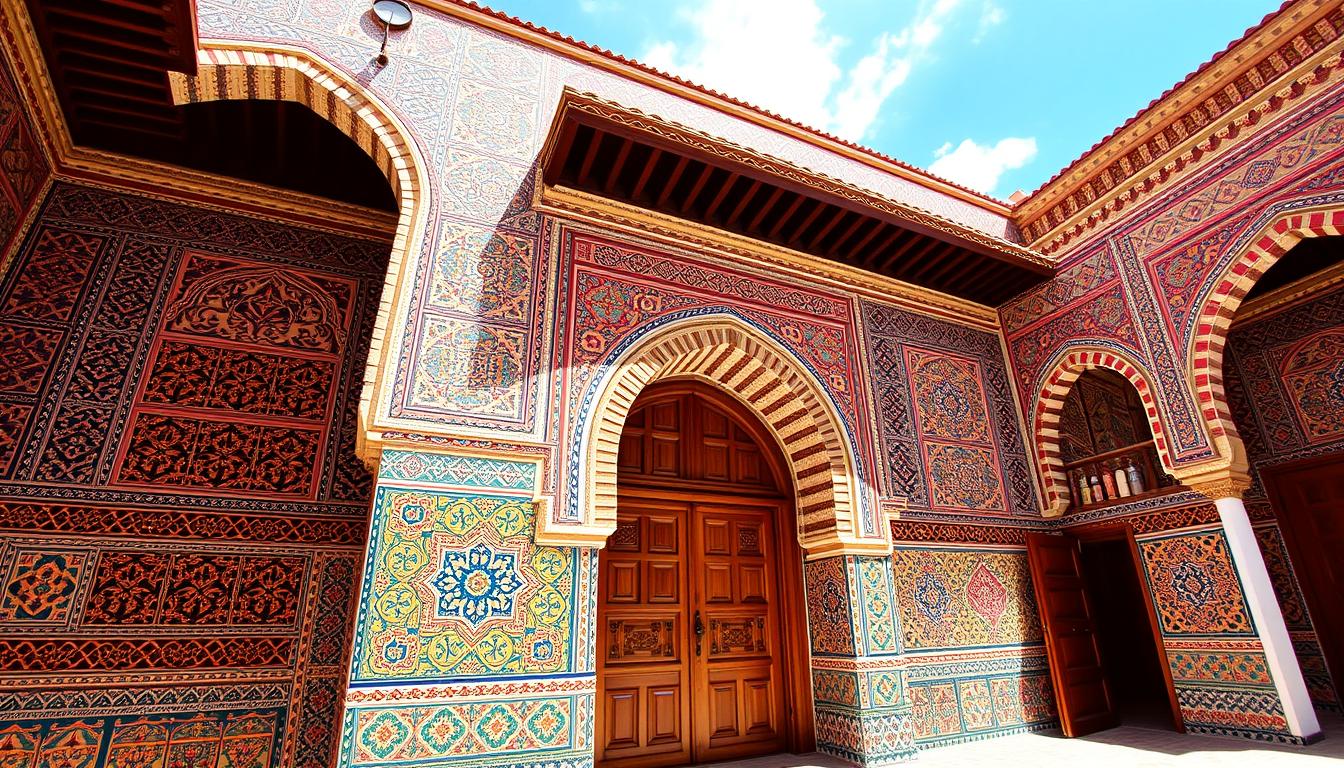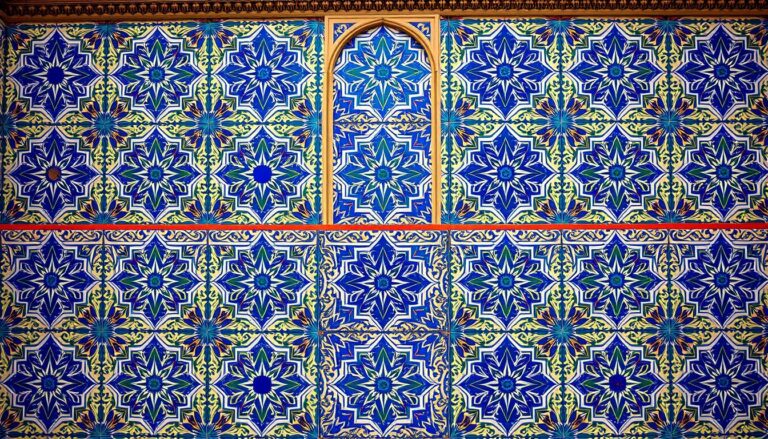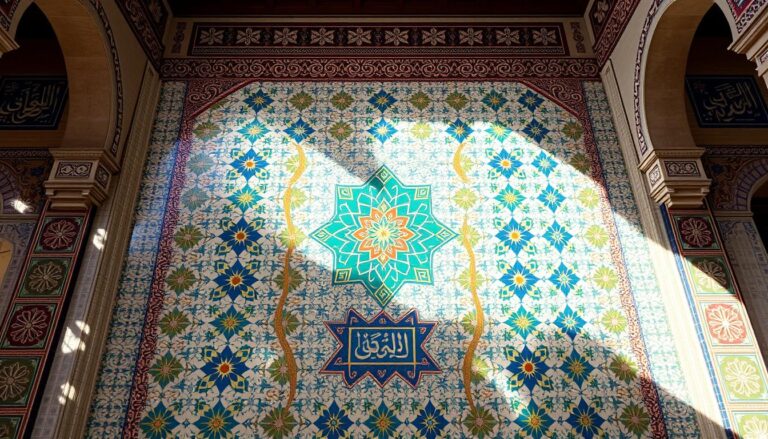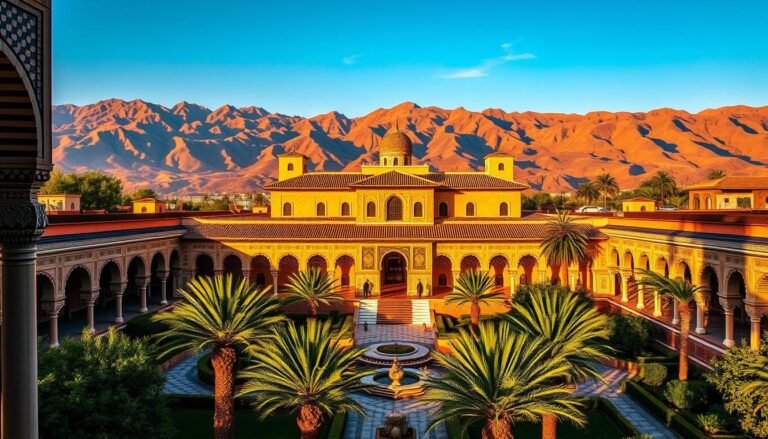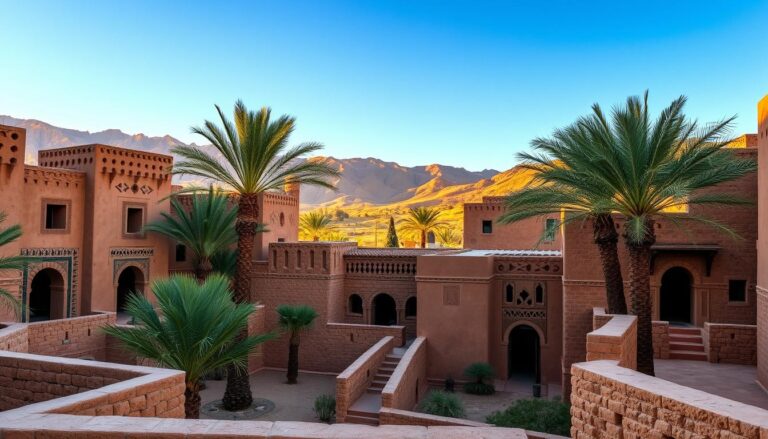What if the secret to green, energy-saving buildings is in Morocco’s old building ways? Morocco is famous for its deep cultural roots. Its buildings show a mix of ancient Roman and Islamic styles, making its architecture unique. Moroccan builders use old skills to create buildings that stand the test of time.
Key Takeaways:
- Moroccan architecture reflects a rich cultural heritage, blending diverse influences from ancient Roman, Islamic, and local Amazigh traditions.
- Vernacular architecture, featuring traditional handcraft skills, is prevalent throughout Morocco, especially in structures like kasbahs and ksour.
- Rammed earth construction techniques are still widely used in Morocco, valued for their sustainability, economic benefits, and thermal regulation properties.
- Moroccan builders often utilize thick walls made of local materials like mud bricks or packed earth, which act as natural temperature regulators.
- Craftsmanship in Moroccan architecture varies from simple earth and clay structures to intricate stucco carvings and mosaic columns in Islamic-style buildings.
The Enduring Legacy of Moroccan Architecture
Moroccan architecture is a mix of ancient Roman, Islamic, and Amazigh (Berber) styles. It creates a unique and striking look. From Fes’s mosques to Marrakech’s riads, this heritage has deeply influenced the country’s heritage preservation, custom home building, sustainable building, and artisanal construction practices.
Ancient Roman and Islamic Influences
The first Islamic-era monuments in Morocco, like the al-Qarawiyyin and Andalusiyyin mosques in Fes, were built in the hypostyle form. They used the horseshoe or “Moorish” arch, showing influences from places like the Great Mosque of Kairouan and the Great Mosque of Cordoba. These elements shaped the unique Moroccan style.
Blending Amazigh Traditions with Islamic Art
The Berber Almoravid and Almohad empires (11th-13th centuries) were key in shaping Moroccan architecture. The Almoravids adopted architectural developments from al-Andalus, while the Almohads introduced new ornamental techniques like muqarnas (“stalactite” or “honeycomb” carvings). They also set the standard for the Moroccan mosque design. This blend of Amazigh traditions with Islamic art created a timeless and harmonious aesthetic.
“Moroccan architecture is a captivating blend of ancient Roman, Islamic, and Amazigh (Berber) traditions, creating a unique and visually striking aesthetic.”
The lasting impact of Moroccan architecture shows its rich cultural heritage and influence on modern design and sustainable building worldwide. From the detailed zellige tilework to the peaceful courtyard riads, Moroccan craftsmanship continues to inspire and fascinate people globally.
The Almoravid and Almohad Empires: Defining Moroccan Design
The Almoravid and Almohad empires flourished from the 11th to 13th centuries. They greatly influenced Moroccan architecture. These dynasties took the architectural styles of al-Andalus and made them their own. They also brought new designs from the East, like muqarnas.
Architectural Marvels of the Almoravids
Almoravid architects were known for their skill and detail. They mixed heritage preservation and artisanal construction in their work. This made their buildings last and hold cultural value. Their mosques set the standard for Moroccan mosques.
The Almohads and the Iconic Kutubiyya Mosque
The Almohad dynasty built upon the work of the Almoravids. The Kutubiyya Mosque in Marrakesh is a key example of their style. It shows the Almohads’ focus on sustainable building and custom home building.
The work of the Almoravid and Almohad empires still amazes people today. It shows the lasting impact of Moroccan design.
“The Almoravid and Almohad empires laid the foundation for Moroccan architecture, blending Moorish influences with local traditions to create a distinctive and enduring style.”
Moroccan Craftsmanship in Construction
In Morocco, the tradition of skilled construction is a legacy of generations. The ancient Kasbahs and iconic fortresses show the mastery of Moroccan builders. Their commitment to quality is unmatched.
Rammed earth construction is a key example of this skill. It’s perfect for the local climate and uses local resources. These structures keep temperatures balanced, making them sustainable and energy-efficient.
The design of these buildings, with open and shaded courtyards, shows the builders’ deep knowledge. They understand how to create a comfortable environment.
“One mistake and the craftsman has to start over, showcasing the level of precision and dedication required in Moroccan craftsmanship.”
But, Moroccan craftsmanship is facing a challenge. Fewer skilled artisans are left to carry on the tradition. The need to preserve these skills is urgent.
In Tetouan, there’s hope. Young artisans are learning the old ways. They are learning metal piercing in specialized schools. This effort is crucial for the future of Moroccan craftsmanship.
The skill in Moroccan construction shows the attention to detail and respect for tradition. As Morocco faces modern challenges, preserving these techniques is key. It ensures Moroccan design remains celebrated worldwide.
Sustainable Building Practices in Morocco
Moroccan homes show the country’s rich heritage and love for nature. They use adobe bricks made from soil, sand, straw, and stones. This method is perfect for Morocco’s varied climate, showing the country’s culture and care for the environment.
Traditional Materials: Adobe and Rammed Earth
Adobe bricks and rammed earth are more than old traditions in Morocco. They are key to sustainable building. These natural materials keep homes cool without needing lots of energy.
Passive Cooling and Climate-Responsive Design
Moroccan builders use smart cooling methods to keep homes cool. They use thick walls, zellige tiles, and riad designs to catch cool breezes. Windcatchers also help, showing Morocco’s lasting commitment to green building.
Places like Les Jardin Des Medina in Marrakech and Riad Laaroussa in Fes are Morocco’s green gems. They show how to mix old traditions with new, green ideas in building.
“Morocco is leading the way in sustainable architecture with its top green buildings, showcasing innovative and environmentally friendly designs.”
Moroccan construction shows the country’s deep cultural roots and green building goals. By using old methods and new ideas, Moroccan homes are both beautiful and comfortable. They inspire others around the world.
Modern Adaptations and Innovations
Morocco’s ancient building wisdom is now key in sustainable living. Moroccan homes show a blend of cultures and artistic growth. They mix old riads with solar panels and modern villas inspired by tradition.
This blend of old and new beauty has drawn global attention. Designers are inspired by Moroccan patterns, materials, and welcoming spirit.
Moroccan architecture combines many cultures, like Arab and Andalusian. These influences brought unique geometric patterns. Colors like blue and green have deep meanings, adding to the beauty.
Geometric patterns in Moroccan design are detailed and striking. They use shapes and motifs to create stunning visuals.
Zellige tiles, with their geometric patterns and colors, add beauty to custom home building and artisanal construction. Moroccan courtyards and riads bring light, ventilation, and privacy. They also inspire modern sustainable building.
Islamic design in Morocco includes geometric patterns and calligraphy. These elements inspire modern architecture worldwide.
Moroccan architecture’s ornate details show the skill of Moroccan artisans. This heritage inspires designers globally, aiming to capture Moroccan design in their work.
Conclusion
Moroccan architecture is a perfect mix of quality workmanship, skilled labor, and care for the environment. The country’s way of doing building trades and construction techniques shows the lasting impact of artisanal construction and the talent of master builders. Morocco’s wisdom is key as we look for sustainable building solutions and preserve our heritage.
For centuries, Moroccan craftsmen have shared their skills, keeping the art of building beautiful homes alive. The variety of custom home building methods and materials in Morocco shows a deep respect for nature. It also shows a commitment to creating homes that are both beautiful and useful.
As more people want eco-friendly homes, Morocco’s approach to Moroccan Craftsmanship in construction is very inspiring. The country’s rich architecture and skilled artisans are changing design trends around the world. Morocco stands out as a leader in sustainable, culturally-rooted building practices.
Source Links
- Morocco – a journey to traditional building crafts
- The Timeless Design of Moroccan Homes
- Moroccan architecture
- The Influence of Moroccan Architecture on Modern Design
- Exploring the Timeless Beauty of Moroccan Architecture | African Sahara
- Exploring the Richness of Moroccan Architecture – Cindrebay
- Moorish architecture
- The Almoravid and Almohad Empires 9780748646821 – DOKUMEN.PUB
- Moroccan Craftsmanship: fading treasures in a rich tradition – Green Olive Arts
- The Forgotten Craftsmanship in Morocco
- Morocco Top Green Buildings
- Sustainable Traditional Architecture of Egypt and Morocco
- The Influence of Moroccan Architecture on Modern Design
- Crafting the City: Focus Morocco – RISD Global
- Innovative Adaptation Of Traditional Building Materials For The Modern Era – Arch2O.com
- Crafting Moroccan Elegance: A Journey into the Production of Handmade
- The Role of Moroccan Culture in Its Export Market
- Moroccan Handmade Market Baskets: A Fusion of Artistry and Functionali

The Editorial Team is a passionate group of Morocco enthusiasts dedicated to sharing the beauty, culture, and wonders of this captivating country. With diverse backgrounds and a deep love for travel, we strive to bring you engaging and informative content that inspires your Moroccan adventures. From uncovering hidden gems and sharing local insights to exploring mouthwatering cuisine and showcasing the vibrant lifestyle, our team is committed to providing you with valuable resources and exciting stories that enhance your exploration of Morocco. Join us on this journey as we celebrate the rich heritage and unforgettable experiences that make Morocco truly special.

